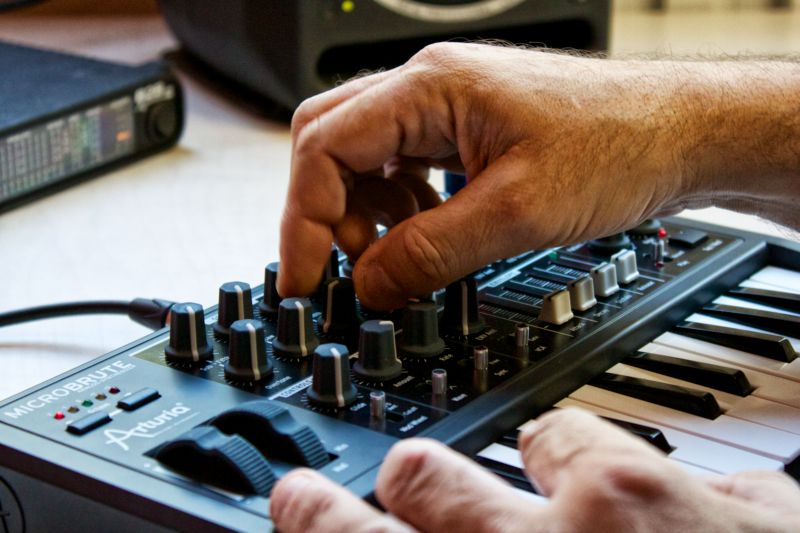
Takes your sound
to a new level
Over a decade on, MicroBrute’s fierce analog character continues to stand out.
With a 100% pure analog signal path, hands-on control, and flexible connectivity via MIDI, USB, and CV/GATE, this small but mighty synth is as relevant as ever, while staying true to its sonic roots.
Oscillator
That punches above its weight
MicroBrute’s single analog oscillator is anything but basic. With waveform mixing, built-in wave shaping, and a powerful sub control, it delivers the kind of raw, versatile tone you’d expect from synths three times the size.

VCO
Blend saw, square, and triangle waves in variable amounts—not just on/off switches. Add bite and variation with Ultrasaw, Metalizer, and pulse width controls.

Overtone
A redesigned sub-oscillator adds thickened lows and complex harmonics. Push it further for 5th-up intervals and modulate it via the Matrix for gritty, expressive tones.

Ultrasaw
Thickens the saw wave with phase-shifted layers. Modulate it with the LFO to simulate detuned multi-oscillator stacks.

Metalizer
Twists the triangle wave into jagged, harmonic-rich shapes. Route the envelope for dynamic sweeps, growls, or tearing leads.
モジュレーションの
怪物
MicroBrute’s modulation goes far beyond the basics
With a full LFO, ADSR envelope, and patchable Mod Matrix, you can shape pitch, filter, Metalizer, and more. Default routings like LFO to pitch and envelope to Metalizer get you started fast, while the mod wheel puts vibrato and filter sweeps at your fingertips.
Override defaults, patch your own routes, or connect to modular gear for external control. Whether you’re after subtle movement or wild, evolving modulation, MicroBrute gives you direct, hands-on flexibility.

Sequencer
details
MicroBrute’s step sequencer combines hands-on control with powerful customization. Build patterns, tweak playback, switch sequences on the fly, and go deeper when you need it.

8パターン
Record up to 8 sequences, each up to 64 steps, and store them safely in internal memory.
Input notes one by one, tap in rests, and switch between patterns instantly or after the current one finishes.
さまざまなモード
Trigger sequences manually or let them loop automatically with Note On and Continuous Play modes.
Use the companion software to adjust step length, sync behavior, and trigger logic to match your setup.
Import/Export
Use the free editor to back up, reload, or swap sequences via USB.
Keep your grooves archived and ready—whether for live shows or sound design sessions.
Essential
I/O
Whether you're syncing hardware, processing audio, or jamming with your DAW, MicroBrute keeps your setup connected.
Play an entire set, compose an entire soundtrack from start to finish. Or, connect to your existing rig for a seamless musical experience.

CV/Gate
Standard 1V/oct CV/Gate makes MicroBrute a great addition to modular rigs. Use its sequencer, envelope, and LFO to control other synths—or let them control the Brute.
Audio In
Run external audio through MicroBrute’s filter and Brute Factor™ for gritty shaping and rhythmic modulation. Great for vocals, drum machines, or anything that needs a twist.
MIDI/USB
Full MIDI I/O via USB and DIN lets you sequence, sync, and play from any controller. MicroBrute fits just as easily into a DAW setup as it does into a hardware jam.









Gallery
Main Features
Monophonic synthesizer
100% Analog audio signal path
Steiner-Parker 2-pole multimode filter (Low Pass, Band Pass, High Pass)
Analog Voltage Controlled Oscillator
Oscillator Mixer (Overtone, Sawtooth, Square, Triangle, audio in [on rear panel])
Overtone sub oscillator/5th generator
Signal enhancers:
Pulse Width Modulation
Ultrasaw generates fat sawtooth waveforms
Metalizer brings in extreme harmonics
Brute Factor™ delivers saturation and rich harmonics
LFO with 3 waveforms (sine, sawtooth, square)
LFO can freerun or sync to arpeggiator
ADSR envelope generator
Keyboard tracking of the VCF cutoff
25-note mini-key keyboard
Mod wheel (assignable to cutoff or LFO amount)
Pitch wheel (bend range selectable via software)
Octave selector from -3 to +2 octaves
External analog audio input
CV In jacks: Pitch, Filter, sub-harmonics, pulse width, Metalizer, saw animator
CV Out jacks: pitch, envelope, LFO
MIDI In with 5 pin DIN connector
USB MIDI In/Out
1/4” audio output and 1/8” headphone output
Full-functioned step sequencer:
8 memories
up to 64 steps per memory
tap tempo
rate control
step divisions (via software)
trigger modes (via software)
MIDI sync
Steel bottom panel
12V DC 1A power supply
What’s in the box
Box content
MicroBrute synthesizer
User manual
Preset sheets
Power supply
2 mini-jack patch cords
Size & weight
Size (mm): 60 x 325 x 221 mm
Size (in): 2.36 x 12.80 x 8.70 in
Weight (kg): 1.75 kg
Weight (lb): 3.86 lb



















